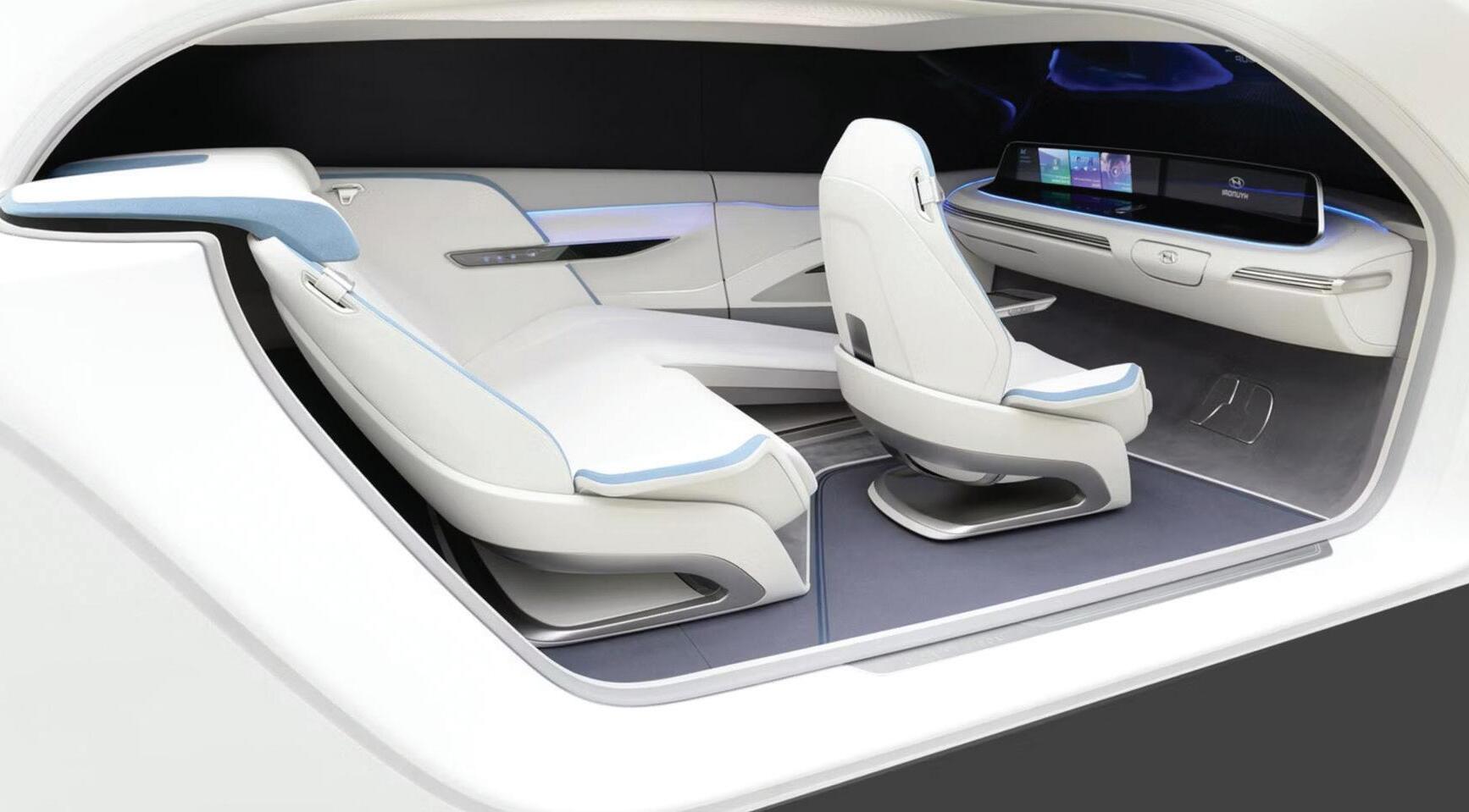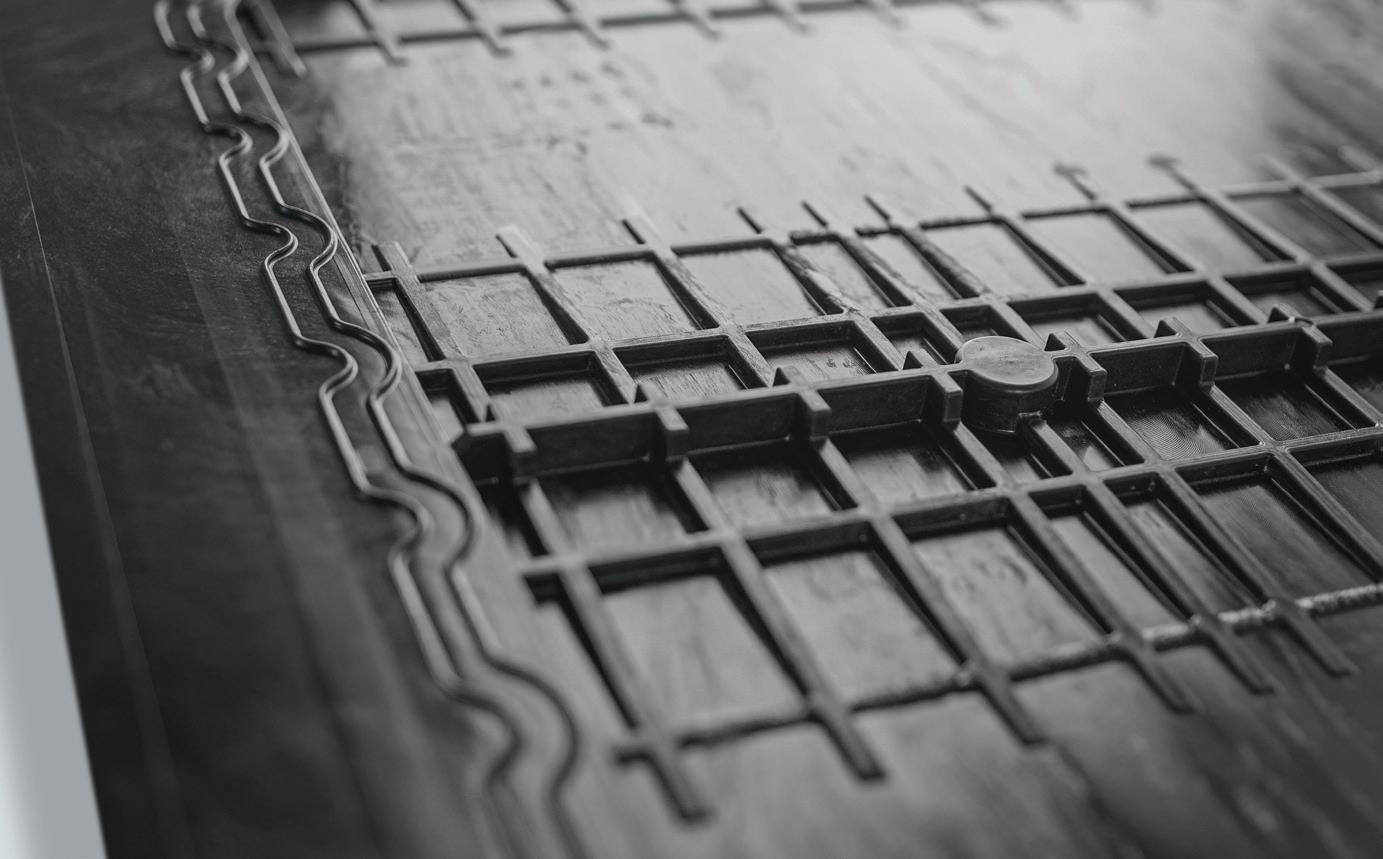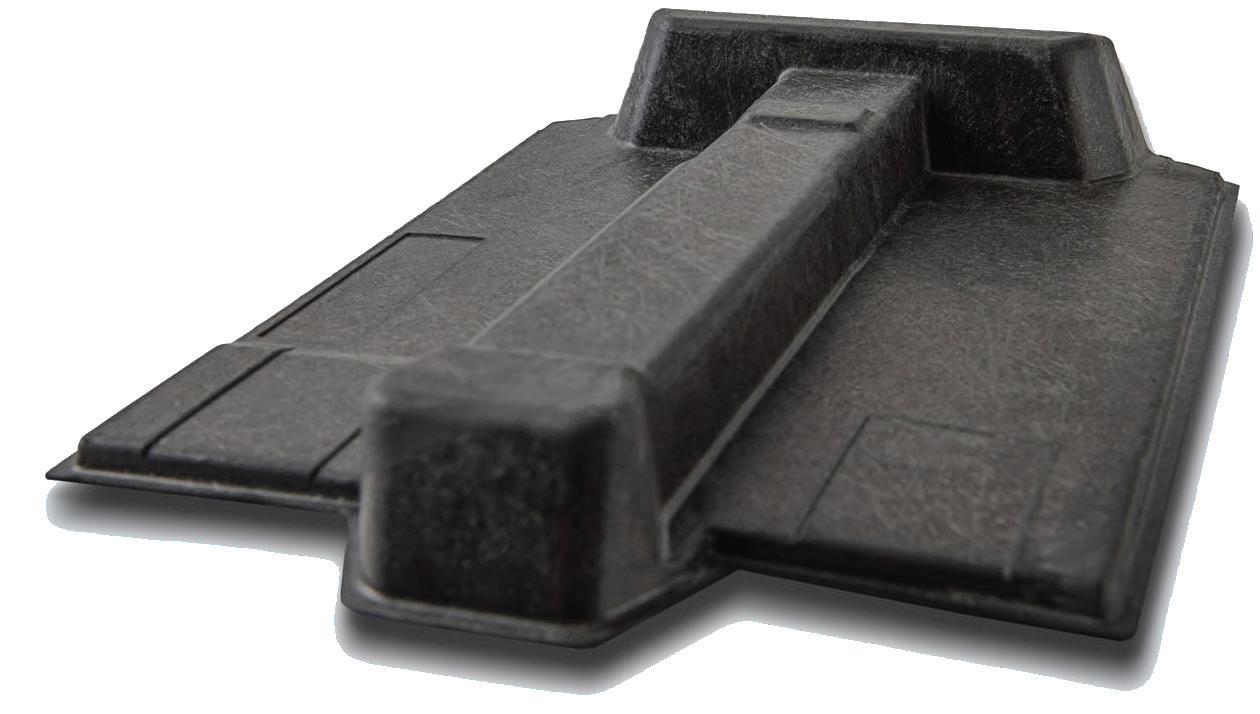
8 minute read
Cars of the Future PORTABLE LIVING ROOMS
With Safety and Comfort at the Fore, Today's Automotive Designers are Prioritizing Vehicle Interiors Over Exteriors as the Industry Moves Toward Greener, Smarter and More Performance-Oriented Textiles
By Geoff Fisher, European Editor, IFJ
Automotive textiles have undergone a dramatic transformation in recent years. Initially used for simple upholstery and interior linings, these highly technical materials now perform a wide range of functions, from enhancing safety and performance, including sound insulation, to improving driving comfort and reducing energy consumption, as well as supporting sustainability and digital connectivity.
Further ahead, the car of the future may not just be viewed as a mode of transportation but also as an extra, mobile living room and workspace – a sensory sanctuary decked with cushions, blankets, and other soft furnishings, as well as heated seats for relaxation, ambient lighting, and air diffusers.
Advanced Materials
Global automakers are now incorporating advanced materials into everything from impact-resistant airbags and reinforced seatbelts utilizing advanced fibers like aramids to interactive, sensorembedded surfaces, creating a new model of vehicle design.
In particular, the shift to electric and autonomous vehicles is changing the applications of textiles in the automotive industry. For example, a vehicle’s interior aesthetics will likely become increasingly important as software and artificial intelligence take over many of the functions previously performed by the driver.
There will also be strong growth in demand for nonwoven components, which are employed as separators in batteries and fuel cells for electric vehicles (EVs), as well as for acoustic barriers and thermal insulation panels to create quieter, more comfortable cabins by dampening noise and efficiently regulating temperatures.
Connected Mobility
Back in 2017, the Germany-based Bosch Group envisaged the vehicle of the future as the “third living space,” alongside a person’s home and their office or workplace. It added that the car would be a private space in which to find comfort for time spent, turning it into a “personal assistant.” This new automated “assist” would be achieved by connecting the vehicle and its surroundings with the internet, which enables personalized communications between the car and its driver and passengers.
On the other hand, the introduction of autonomous vehicles could also lead to an increase in self-driving fleets and ultimately result in the eventual elimination of car ownership itself. Under a “subscription” or shared-vehicle model, automotive interior fabrics will need to have more heavy-duty durability, as well as easyclean and antimicrobial properties.
Furthermore, autonomous or fleet vehicle interiors will need to be frequently refurbished, more so than current singleownership cars, which suffer significantly less wear and tear.
Whether single-owned or shared, vehicle interiors are beginning to follow the latest trends in the home textiles sector, which emphasize sustainability, customization, and personalization while integrating innovative technology and smart fabrics. This shift maintains an overall focus on safety and comfort.
However, highly autonomous driving is still some way off, and many analysts do not expect fully self-driving cars to be adopted widely on highways and roads until 2050 at the earliest.
High-Performance Fabrics
The most visible automotive textiles are those used for interior upholstery –high-performance fabrics cover seats, headliners, door panels, and dashboard components. These materials can offer a luxurious feel while remaining durable and easy to clean. In contrast, floor coverings require appeal from harder-wearing fibers. Advanced upholstery fabrics must also resist stains and fading, which is essential for maintaining a vehicle’s appeal – and resale value – over time.
Integrating engineered fabrics to withstand such extreme conditions is a growing significant development. These materials are not only durable and lightweight but also provide more critical functions, such as fire resistance, impact protection, and ultraviolet resistance. Developments like nano-coatings and functional finishes can enhance properties such as stain resistance and durability, enabling automotive components to maintain both their aesthetic appeal and structural integrity under demanding conditions. Such materials also contribute to reducing the overall vehicle weight – a key factor in enhancing fuel efficiency and lowering emissions.
Smart Solutions
The rise of smart textiles in automotive manufacturing marks a significant step forward toward interactivity and connected safety. Embedded sensors in fabrics can monitor parameters such as temperature, humidity, pressure, and even the driver’s posture and vital signs, providing real-time data to improve safety and comfort.
For example, a temperature-regulating seat cover can automatically adjust according to external conditions or user preferences, while interactive surfaces enable touch-based controls without the need for conventional buttons.
In EVs, lightweight textile composites can help reduce overall vehicle weight, thereby extending battery life. Further, the combination of carbon fiber and resininfused fabrics offers high strength at a fraction of the weight of traditional materials. These composites undergo rigorous testing to ensure they meet safety standards while enhancing performance.
Eco-Friendly Alternatives
Environmental consciousness and the drive towards eco-friendly alternatives have spurred innovation within the automotive textile sector.
Original equipment manufacturers (OEMs) and their suppliers are increasingly embracing sustainable materials such as recycled polyester, bio-based textiles, and even fabrics produced from reclaimed marine plastics.
For example, Renault has used pineapples and linen in the development of the Renault Emblème demonstration vehicle by Ampere, its French automaker
Textile-based airbags now utilize sensor arrays to detect collisions and deploy airbags more accurately. Seat and door panel fabrics can incorporate embedded light-emitting diodes and microcontrollers to display ambient lighting effects, creating a more engaging and futuristic user experience while enhancing safety and comfort.
This merging of digital technology with traditional materials is paving the way for smarter, safer, and more responsive vehicle interiors. Such innovative materials can also contribute to energy efficiency.
At CES 2017, Hyundai Motor unveiled its Smart House technology through its Mobility Vision concept, which blurs the line between mobility and living/working spaces. It expands a vehicle’s essential role in daily life as more than a means of getting from A to B.
EV subsidiary. For the vehicle interior, technology company Forvia selected coverings made from recycled and natural materials. The contact zones on the door panels and central console have been upholstered in skins made from pineapple fibers, while the dashboard comprises linen upholstery made in Normandy, France.

Interior Components
Meanwhile, Bcomp, a Switzerland-based producer of flax fiber reinforcements, has partnered with Kia to integrate its natural fiber composite material ampliTex into key interior components of the new Kia Concept EV2, a B-segment electric sport utility vehicle.
The South Korean carmaker has also announced details of collaborations with bio-based materials companies Simplifyber and Biomyc to integrate further environmentally conscious interior components into the Concept EV2.
Simplifyber developed the vehicle’s dashboard and door panels using its proprietary cellulose-based formulation, Simplifyber Fybron – a material composed of a blend of sources, including wood, paper, and/or recycled textiles.
The formulation used for the Concept EV2’s interior consists of 56% FSCcertified cellulose fibers (3% wood pulp, 25% lyocell), 21% FSC-certified natural rubber latex, 12% bio-based binders and 11% synthetic fibers. The liquid-based manufacturing process eliminates the need for spinning or weaving, with the material produced at Simplifyber’s facility in Raleigh, North Carolina, USA.
Kia’s partnership with materials design firm Biomyc incorporates durable, biodegradable components grown by the Bulgaria-based company as part of the Concept EV2’s interior. Crafted from


Autonomous driving technology offers up the opportunity to revolutionize the look and feel of cars. As people will not need to concentrate on driving, they will have more time for other activities, such as working, resting, or watching a film. Hyundai mushroom-based material (hemp and mycelium), the partnership also employs an advanced coloration process that achieves Kia’s specified Pantone shades precisely.
Circuline Range
Earlier this year, India-based Tier 1 systems supplier Supreme Group launched the Circuline range at the Bharat Mobility Component Show held in New Delhi, India. The new product range focuses on sustainable materials for automotive interior soft trims and noise, vibration and harshness (NVH) solutions for OEMs.
The materials prioritize the use of renewable, biodegradable and natural resources, particularly plant-based fibers and new bio-based alternatives, maximizing the use of recycled content and minimizing environmental impact through every stage of production.
Recycling
Recycled yarn is now being used in the Eletre and Emeya EV models from Lotus, a British manufacturer of luxury sports cars. The Nm 15 open-end Wyron Truecycled yarn, which consists of 50% postconsumer textile waste and 50% recycled polyester, is used for the back sections of the seats and is produced by Germanybased Brain of Materials, utilizing technology from German textile machine builder Trützschler.
In the EV sector, Taiwan-based Swancor has partnered with Spanish start-up Linux for the Geko prototype vehicle, utilizing recycling technology used for automotive body parts.
Particularly, Swancor EzCiclo recyclable resin is being applied to the vehicle’s fenders, bumpers, doors, and tailgate for recyclability. The resin and linen fiber parts are fully decomposable through Swancor’s patented CleaVer liquid at
Autoneum has introduced the E-Fiber flame shield, based on a composite material made of reinforcing fibers and resin, to minimize the risk of fire accidents from lithium-ion batteries and protect vehicle occupants in the event of thermal runaway. Autoneum

150˚C for four hours, which separates the resin and linen fiber. The Liux Geko prototype was seen at the JEC World Composites Show held in March in Paris, France.
The decomposition process is said to generate no waste liquid or exhaust and will lower the carbon footprint compared with incineration. The recycled linen is reprocessable into yarn after being carded, drawn, and twisted, while the recycled resin is usable in the original product after undergoing chemical modification and formula adjustments.
Carbon Fiber Recycling
Carbon fiber-reinforced polymers (CFRPs) are now widely used as composite materials due to their lightweight and strong properties, making them ideal for various applications in fields such as aviation, aerospace, automotive, wind power generation, and sports equipment. However, recycling CFRPs presents a significant challenge, with waste management being a particularly pressing issue.
In a recent study, researchers from Waseda University, Japan, demonstrated a novel direct discharge electrical pulse method for the efficient, effective, and environmentally friendly separation of CFRPs to recover high-quality carbon fibers. The technique utilizes Joule heat generation, thermal stress generation, and expansion force due to plasma generation, foregoing the need for heating or chemicals.
Upcycling Method
In an alternative approach, researchers at the University of Southern have developed a process to upcycle composite materials used in aircraft, automotive panels, and light rail vehicles.
The chemistry demonstrated in their study shows that composite materials can be recovered and recycled in a manner that preserves their integrity. The new upcycling method saves the carbon fibers of the CFRP, which are the strong, durable parts of the material. These fibers remain in good condition, and the research team has demonstrated how they can be reused in new manufacturing processes, retaining more than 97% of their original strength.
that shields EV batteries from impact, fire, and corrosion.
Earlier, Autoneum introduced the EFiber flame shield, based on a composite material made of reinforcing fibers and resin, to minimize the risk of fire accidents from lithium-ion batteries and protect vehicle occupants in the event of thermal runaway, in which the battery heats up quickly and uncontrollably and, in the worst case, ignites or explodes.
Meanwhile, the Swiss company has signed an agreement to acquire all the shares of Chengdu FAW-Sihuan Interior Parts, a Chinese automotive supplier specializing in acoustic and thermal management. This agreement follows the recent completion of the acquisition of a 70% majority stake in Jiangsu Huanyu Group, another leading supplier of lightweight components for light and commercial vehicles in China.

Aegis FibreTech is commercializing novel ultra-lightweight insulation to improve efficiency and safety in vehicles.
Aegis FibreTech/UK University of Birmingham Enterprise
Biotechnology recovers the value from the discarded polymer matrix through a special type of fungus that can rebuild the material from the composite matrix after the fiber recycling reaction chops the polymer into benzoic acid. It is then utilized as a food source for the fungus to produce (2Z,4Z,6E)-octa-2,4,6-trienoic acid.
Acoustic and Thermal Insulation
In the field of acoustic and thermal insulation for vehicles, Switzerland-based Autoneum continues to produce a range of new developments, including a lightweight composite impact protection plate
The acquisitions are designed for Autoneum’s Business Group Asia to expand further its customer base, including other major Chinese vehicle manufacturers such as FAW-VW, FAW-Audi, FAW-Toyota, and Geely. Finally, Aegis FibreTech, a spinout from the UK’s University of Birmingham, is commercializing novel ultra-lightweight insulation to improve efficiency and safety in automotive, motorsport, and aviation applications. Used to protect from high engine or exhaust temperatures, the new material for thermal insulation, based on electrospun fibers made from undisclosed “environmentally friendly materials,” is designed to have low thermal non-conductivity, low density, and low thickness.
Geoff Fisher is the European editor of International Fiber Journal and editorial director of UK-based Textile Media Services, a B2B publisher of news and market reports on transport textiles, medical textiles, smart materials, and emerging markets. He has almost 40 years of experience covering fibers and technical textiles and can be contacted at gfisher@textilemedia.com.










